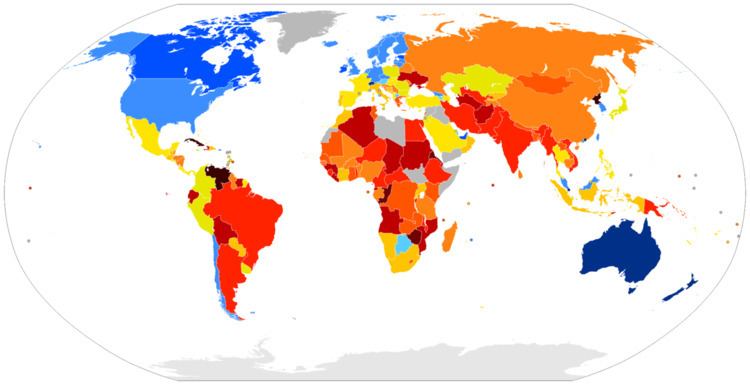 | ||
A number of indicators of economic freedom have been proposed. They differ in the methods by which they have been constructed, the purposes to which they have been put and the conception of economic freedom they embody.
Contents
Index of Economic Freedom
The Index of Economic Freedom is a series of 10 economic measurements created by the Heritage Foundation and Wall Street Journal. The Index's definition of economic freedom is the following; "Economic freedom is the fundamental right of every human to control his or her own labor and property. In an economically free society, individuals are free to work, produce, consume, and invest in any way they please, with that freedom both protected by the state and unconstrained by the state. In economically free societies, governments allow labor, capital and goods to move freely, and refrain from coercion or constraint of liberty beyond the extent necessary to protect and maintain liberty itself."
The index scores nations on 10 broad factors of economic freedom using statistics from organizations like the World Bank, the International Monetary Fund and the Economist Intelligence Unit:
The 10 factors are averaged equally into a total score.
Economic Freedom of the World
The annual survey Economic Freedom of the World is an indicator of economic freedom produced by James Gwartney and Robert Lawson, and is published by the Canadian Fraser Institute. The index uses a definition of economic freedom similar to laissez-faire capitalism and it has been more widely used than any measure of economic freedom. Its use stems in part from the longer time period covered (data exists from 1980–2008), and the fact that this index is constructed from third party information (in contrast to the index created by the Heritage Foundation). According to the index, the cornerstones of economic freedom are personal choice, voluntary exchange, freedom to compete, and security of privately owned property.
In practice, the index measures:
The report uses 42 distinct variables collected from a number of different sources (including the World Bank, the International Monetary Fund, and others). Some examples: tax rates, degree of juridical independence, inflation rates, costs of importing, and regulated prices. Each of the 5 areas above is given equal weight in the final score. Scores are available (largely dependent on data available) for 141 countries.
World Survey of Economic Freedom
Freedom House published a measure of economic freedom in 1996, but publication of this measure has been discontinued. They defined economic freedom through two dimensions – lack of state infringements on citizens' rights to exchange goods and services, and state establishment of the rules governing contracts, property rights and other institutional prerequisites required for the conduct of economic affairs. To determine level of economic freedom Freedom House used six indicators:
India
Two different measures have been proposed for India, both called Economic Freedom Index for India. One is produced by Bibek Debroy, Shubashis Gangopadhyay and Laveesh Bhandari and places weight on measures of both positive freedom and negative freedom. The other is an adaption of the Fraser Institute measure produced by the Rajiv Gandhi Institute for Contemporary Studies.
Central Asia
In the 2016 Index of Economic Freedom, Kyrgyz Republic and Tajikistan ranked as "mostly unfree" taking 96th and 149th places 178 respectively. Uzbekistan (#166) and Turkmenistan (#174) ranked as "repressed". Largest economy in the region, Kazakhstan is ahead of all other Central Asian countries and neighboring Russia. Kazakhstan ranked an overall score of 63.6 out of 100 taking 68th place out of 178 countries, one place better than last year.
Criticism
It has been argued that the economic freedom indices generally lump together unrelated policies and policy outcomes to conceal negative correlations between economic growth and EF in some subcomponents. Most of these criticisms are now considered outdated. In a review of the literature, Lawson and Hall documented that "[o]ver two-thirds of these studies found economic freedom to correspond to a 'good' outcome such as faster growth, better living standards, more happiness, etc. Less than 4% of the sample found economic freedom to be associated with a 'bad' outcome such as increased income inequality." Furthermore, supporters contend that the size of government has shown correlations with negative growth.
